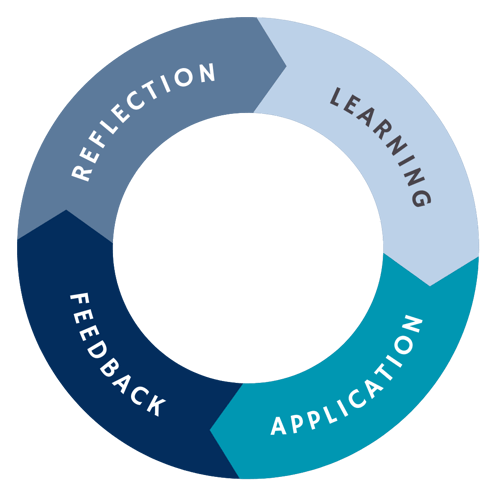When designing an impactful and effective L&D strategy, there are many tried and tested learning concepts and styles to consider. Many of these styles have significantly grown in popularity in recent years, such as blended learning or the flipped classroom strategy. But a learning concept that has remained popular for many years in educational practices and workplace training is the learning loop. In this blog, we’ll explore this popular learning method and how to deliver it.
Blog contents
Definition – A learning loop is a four-stage cycle: knowledge acquisition, application, feedback, and reflection.
Why Use It – Find out how it encourages continuous learning, accountability, and agile improvement.
Stage 1 – Deliver engaging content via LMS or peer-to-peer learning.
Stage 2 – Apply knowledge through tasks or e-learning assessments.
Stage 3 – Gather two-way feedback to enhance learning outcomes.
Stage 4 – Reflect on progress and plan future learning.
Get Started – Next steps for using e-learning tools to create effective learning loops.
What is a learning loop?
A learning loop refers to the iteration of four key stages that allow learners to work through a continuous cycle of learning and development. The four stages are:
- Knowledge acquisition – This can be achieved through methods such as linear teaching practices, learning through experience, and e-learning L&D courses.
- Application of knowledge – This stage requires learners to apply what they have learnt; this could be through practical tasks or assessments designed to test knowledge acquisition.
- Feedback – This provides learners and educators/employees with the opportunity to discuss completed learning and deliver feedback.
- Reflection and planning – Using the insights taken from previous stages, now is the time to reflect and plan for the future.

Why apply this concept within your L&D strategy?
There are a number of benefits associated with the learning loop concept, including:
- Fostering a culture of continuous learning, improvement and development
- Allowing employers/educators to be more agile and adaptable when it comes to delivering learning opportunities
- Challenging current learning practices and identifying areas for improvement
- Encouraging learners to take accountability and be more self-aware when it comes to their L&D activities
- Identifying strengths and weaknesses at an organisational level and on an individual basis
How to create a learning loop
Stage 1: Knowledge acquisition
Perhaps the most straightforward stage in the learning loop, the knowledge acquisition stage simply involves the facilitation of learning opportunities. Learning opportunities may be afforded to learners through experiential learning in a working environment or may be delivered through structured L&D practices.
It’s important to keep the latter stages of the learning loop in mind when designing a learning strategy. As learners and educators/managers will need to take part in some reflection and assessment of the learning experience, learning opportunities that can easily be reviewed and measured are beneficial. The best way to achieve this is to use an e-learning platform such as a learning management system (LMS) that can deliver powerful learning opportunities within a system that provides a clear record of performance and activities. With an LMS, employers or educators can create comprehensive learning plans for learners to follow. These learning plans can be personalised to suit the individual L&D needs of each learner, and with powerful e-learning content creation tools learning resources can be made especially engaging – which will increase the likelihood of knowledge acquisition and retention.

Another key learning strategy to include in this stage is peer-to-peer learning - a process that is particularly useful in the workplace environment. In fact, an article in the Harvard Business Review noted that peer-to-peer learning encompasses all four stages of the learning loop as it requires knowledge sharing and discussion, along with reflection and feedback amongst peers. With this in mind, it’s worth encouraging employees to engage with one another in a learning environment, whether it be through knowledge-sharing sessions in the workplace or using collaborative tools such as a learning experience platform (LXP).
What is an LXP? Read our ultimate guide.
Stage 2 – Application of knowledge
The next stage of the learning loop asks learners to apply and demonstrate the knowledge they acquired in stage one. This helps both learners and managers/educators understand the strength of their knowledge base after completing initial learning and this can be carried out in several ways.
Learners may be asked to apply their knowledge practically in a physical setting, such as carrying out supervised tasks in a workplace environment. Although effective, this can be impractical to manage and measure so using e-learning tools that collate data-driven evidence is the most reliable option. Using an LMS, learners can complete activities that require them to demonstrate their knowledge in a virtual setting. For example, interactive scenario-based lessons that require learners to apply their knowledge to a real-life situation by working their way through a problem or navigating a situation.
Alternatively, e-learning assessments such as quizzes or timed tests can be designed to test learner knowledge on specific topics and subject matter. Using e-learning technology, learners can complete assessments and results will be automatically collated and distributed to the relevant parties, providing instant and data-driven insights into the progress of learners and evidence of knowledge acquisition.
Discover 5 ways to get the most out of e-learning assessments here.
Stage 3 – Feedback
Providing opportunities for open and constructive feedback is a practice that is often overlooked within L&D programmes. Using a learning loop to deliver L&D opportunities prevents organisations from falling into this trap as feedback comprises one of the four key stages of the loop. Creating avenues for two-way feedback allows both learners and employers/educators to voice any concerns, comments and observations that will help improve the learning experience and outcomes.

The most effective way to facilitate valuable feedback opportunities is to use a performance management system such as Totara Perform. Features such as 360 feedback tools and one-to-ones streamline and enhance feedback processes, allowing managers and educators to provide feedback on learner progress and also allowing learners to give feedback on their experiences during stages one and two of the learning loop. For example, if a learner found an assessment in stage two too challenging, this may indicate that the lessons and learning opportunities in stage one need to be revised – which leads us to stage four.
Read our ultimate guide to performance management systems.
Stage 4 – Reflection and planning
The final stage of the learning loop requires participants to reflect on insights gathered from the previous stages to gain a deeper understanding of what has or hasn’t proven to be successful, identify where improvements can be made, celebrate achievements, and lay out plans for future learning.
The reflection stage can help identify skills and knowledge gaps that weren’t addressed in stage one and provide learners with a chance to voice any aspirations for further development beyond what they have learned already. Employers or educators can create plans for future L&D using e-learning tools such as competency frameworks and learning paths. Once this process is complete, learners can move on to the knowledge acquisition stage and start the learning loop again.

Additionally, this stage can be used to improve L&D processes by evaluating learner feedback and identifying patterns that may indicate areas that need to be improved, such as a lesson that has produced low engagement levels. Once again, this information can be used to restructure and improve future learning opportunities in the next stage of the learning loop.
Discover how to create a personal development plan with a talent experience platform here.
Create a learning loop with the right e-learning tools
If you like the sound of this effective L&D concept, perhaps you’re ready to implement it within your strategy. If so, you’ll need the right e-learning tools and systems to support any activities and processes so that you can maximise the potential of your learning loop. Our robust e-learning platforms provide all the functionality and tools required to achieve this, visit our product pages to find out more or get in touch with one of our e-learning experts today.

Contact Hubken today
Quick responses and clear advice, we're here whenever you need us. Our friendly e-learning specialists are ready to help and will be in touch shortly after you've sent your message.
.png?width=1080&height=150&name=Slim%20blog%20CTAs%20(16).png)
.png?width=1080&height=150&name=Slim%20blog%20CTAs%20(12).png)



